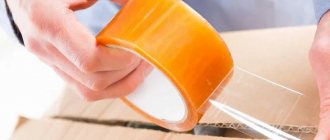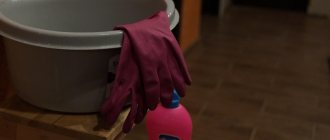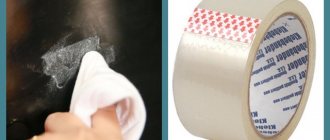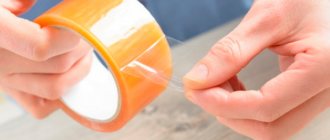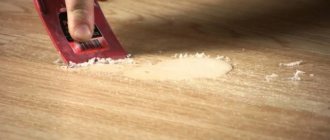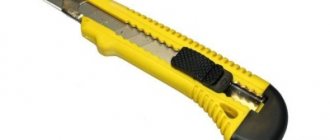In everyday household activities, people often use adhesive tape. It is simply irreplaceable when carrying out repair work, when it is necessary to connect parts or reliably protect the base from external influences. In addition, using the popular tape is extremely convenient and easy. But at the same time, it is worth remembering a small feature of using such material: sticky marks subsequently remain at the place where it is glued. Getting rid of them is not always easy. Therefore, users often have a question: how to remove glue from tape? This problem is solved in different ways, it all depends on the nature of the base that requires cleaning, as well as other factors.
Adhesive tape (scotch tape) is a narrow film coated with glue, which is produced in the form of narrow rolls of various thicknesses Source optitraderus.ru
Types of adhesive tapes
Depending on the adhesive base, as well as the method of application, all adhesive tapes are divided into several types:
- Painting (paper). Rubber glue is thinly applied to the base.
- Packaging. A transparent adhesive composition is used in its production.
- Building. It can be two-sided or one-sided. The adhesive contains acrylic substances.
- On a foam base (double-sided mounting). Produced in various colors, gluing is performed with compounds containing rubber or acrylic.
Advice! When using a specific type of tape, you should take into account: it is always easier to remove adhesive residues of rubber-based products from any surface.
Table: what types of tape exist
| Type of tape | How to use | Base type | Does it leave marks? |
| Stationery adhesive tape | In offices, shops and schools for gluing paper and cardboard | Acrylic | No |
| Packing tape | In production for packaging products | Acrylic | Yes |
| Colored tape | In production for labeling different products in identical packaging boxes | Acrylic | Yes |
| Scotch tape with logo | In production as an additional advertising medium | Acrylic | No |
| Masking tape (crepp) | To protect the surface from construction work | Rubber | No |
| Reinforced adhesive tape | For various repair work, waterproof | Rubber | Yes |
| Double-sided tape | Holds two objects together | Acrylic | Yes |
| Mounting rubber thick tape | For fixing plexiglass | Acrylic | No |
Why does any tape leave marks?
After removing the adhesive tape, there is always glue left on the surface, but the amount may vary. It all depends on compliance with the technology for removing adhesive material. Before using such a product, you need to find out how you can remove the adhesive from tape from different types of bases. Additionally, you should consider:
- what cleanser is available and how effective it is;
- the structure of the contaminated surface (porous materials are more difficult to clean);
- duration of contact.
It is worth starting the cleansing procedure early. If the sticky residues have time to dry, then later they will first have to be brought to a sticky state, and then dissolved.
If traces of any type of tape are left on the surface for a long time, it will be very difficult to clean them off later. Source kraski-net.ru
How to wash natural or synthetic fabrics
As soon as you find traces of adhesive tape on fabrics, begin to act immediately, before the glue hardens and is absorbed into the fibers of the fabric.
Alcohol or acetone
You need to moisten a cotton swab or a cotton pad folded in half with solvent (use the corner of it) and wipe the dirty mark. The solvent can be used on durable, non-fading fabrics, but it is not at all suitable for printed or patterned fabrics, dyed fabrics and thin material.
Acetone dissolves tape adhesive
Soap solution, washing powder or soda solution
You need to soak the clothes for half an hour to an hour, and then rinse, first of all paying attention to areas with traces of adhesive tape and carefully removing the glue from the fabric with your hands.
Washing machine
Try washing things in a washing machine, setting it to a specific mode for each specific type of fabric. It is advisable not to set the spin program after washing - this way you will have the opportunity to check whether the adhesive tape remains on the surface of the fabric or not.
Gasoline, kerosene, and other oil-based solvents leave permanent greasy stains on fabrics, so using them to remove tape from clothes is not recommended at all.
How to remove marks from masking tape
Fresh glue from paper tape can be easily removed from any base using the following means:
- Alkaline compounds. Ordinary laundry soap also contains alkali, but in small quantities. Therefore, it is considered less effective than highly alkaline agents (for example, caustic soda). The soap composition is generously applied to the contaminated base, left for about ten minutes, then removed with a dry cloth.
- Alcohol. Both methyl and ethyl, as well as any alcohol-containing solutions, are perfect. You just need to soak a cotton pad in the liquid, then thoroughly treat the surface.
Important! Some materials do not tolerate contact with alcohol mixtures. For example, plastic subsequently comes into contact with the latter and loses its attractive gloss.
With repeated application, laundry soap can completely remove traces of tape from the surface Source soap-teco.com
How to remove masking tape correctly
If the paper tape has not had time to dry, then removing it is not difficult at all. To do this, you need to pry it up by one of the edges and gently pull it in the opposite direction. Moreover, all movements must be smooth. Remains of the adhesive composition can be easily removed with oily vegetable oil.
When the tape has been on the base for a long period of time, it will have to be soaked with water in advance. It is recommended to use a sponge and thoroughly wipe the surface. After a while, the glue will absorb moisture, and the paper will get wet, so it will be easier to remove it. The resulting residues are quickly removed with any degreaser.
Advice! If after removing the masking tape there are very few marks left, it is recommended to use a soft eraser to remove them.
If the masking tape was applied to the base recently and has not yet had time to dry, then removing it will not cause any difficulties Source kraski-net.ru
How to remove glue after removing tape
There are many different methods, a huge number of preparations that allow you to efficiently remove traces of adhesive tape from all types of surfaces. It is permissible to use both special formulations sold in stores and folk remedies. Moreover, they should be selected depending on the type of base.
Removing masking tape and its traces
Lift the corner of the glued tape and, tilting it 1800 from its original position, pull with even force. Thus, any masking tape that has been selected and applied in accordance with the manufacturer’s recommendations can be removed easily and effortlessly.
Otherwise, masking tape removal is accomplished 96% of the time using a commonly available tool. Highly specialized devices will also be discussed below. But first, it’s advisable to try what you always have on hand. Those materials that can be purchased quickly and inexpensively are also acceptable.
Entry level tool
- a roll of fresh masking tape 30 mm wide (from 150 rubles);
- a sheet of sandpaper or a sanding sponge with 400 grit (from 50 rubles);
- a block of elastic rubber in any form - an eraser, a valve from a tubeless wheel, a part of a rubber band, which is used for preventive repair of shoes. The main thing is that it is comfortable to hold (from 30 rubles);
- artistic brush with fine bristles (from 15 rubles);
- a package of cotton pads or soft, highly absorbent fabric (up to 50 rubles).
It is necessary to remove the masking tape from the surface after painting after 3-4 hours. If it dries completely, the paint may come off along with the tape, so it is not recommended to wait too long
Video description
How to clean windows from tape - how to remove sticky glue from plastic windows
Removing adhesive from glass
You can clean the glass surface from glue using the following proven methods:
- Place a new one on the old tape. Then heat the iron slightly and run it over the stripes. As a result, you need to pick up the edge of the tape with a sharp object and remove the two strips together.
- White spirit, gasoline, and other petroleum products are excellent solvents.
Typically, rubber glue (even if it is dried) is intensively affected by the solvent. Removing the acrylic composition is much more difficult, since a separate preparation must be selected for each adhesive tape.
The easiest way to wipe off the adhesive from tape from glass is with household solvents: they remove both fresh and old traces Source kraski-net.ru
How to clean glass
Cleaning glass is unacceptable when using a melamine sponge - there is a risk of micro-scratches. But products with a chemical composition, on the contrary, perform excellently and safely when interacting with glass and adhesive from tape.
Window cleaner
Brands that will cope with an unusual task brilliantly:
- Mister Muscle.
- Cif.
- Proper.
Mr. Muscle Proper Cif
Recommendations:
- Wet the sponge and scrub the surface.
- Rinse off any remaining household chemicals with water.
The principle of action is similar to regular window cleaning, but with a longer effect on the problem area.
Ammonia
Medical or technical ammonia will not only remove the glue, but will also help achieve a mirror-like surface shine.
Step-by-step instruction:
- Take alcohol and a rag.
- Soak a clean cloth in the solution.
- Using circular motions, wipe the glass with any remaining tape.
- Rinse and wipe dry.
Do not use pure ammonia, but diluted one. Take no more than 2–3 ml of alcohol per liter of water.
White Spirit
Have to take:
- White Spirit;
- sponge
To remove glue from tape, you need to:
- Dip the sponge into the solvent.
- Soften and then remove the adhesive layer.
- Wash with soapy water.
- Wipe with a dry cloth.
White spirit is the main ingredient in WD-40, so the latter product can also be used to remove adhesive from tape. WD-40 will help remove the tape itself - just add a small amount of the product when removing it, and the tape will come off without any problems.
Oil (editorially verified)
If the stain is completely fresh, you should use vegetable oil to clean it. You just need to lubricate the stains with it and leave it for 10-15 minutes, and then clean the softened stains with a damp cloth. Remove any remaining residue with a dry cloth or sponge.
You can also use vegetable oil to remove traces of adhesive tape from furniture.
Checked by the editors: There are old tape marks on the furniture that have accumulated dust and dirt (a children's musical educational poster was attached). The surface was generously greased with ordinary vegetable oil. Leave to act for 15 minutes. Wipe with a damp cloth.
For the purity of the experiment, a sponge with stiff bristles or cleaning powder was not used (although I really wanted to). Somewhere I had to apply oil again. The result is in the photo below. Conclusion: the method really works even with old stains.
Essential oil copes very well with this task. Moreover, absolutely any will do, since all ethers are chemically active substances, here you need to be careful and use rubber gloves. You can also make a mixture of essential and vegetable oils.
When using such furniture cleaning products, you should definitely test them on an inconspicuous area.
Solvents
To remove the adhesive base, you can try using available solvents containing acetone, white spirit or gasoline. When using them, you must take precautions, because volatile substances with a pungent odor can at least cause dizziness. Work with them should be carried out in a room with good ventilation.
Contamination should be removed with a cotton pad or napkin soaked in the selected product. After wiping the glass with a solvent, after a while, thoroughly wash the surface with a glass cleaning spray or a solution with soap.
Video description
Easily remove the tape from the glass.
How to remove adhesive from tape from metal
To effectively remove dirt from a metal surface, it is advisable to use:
- Freezing method. Place some ice in a plastic bag, which is then applied to the contaminated base. After 20 minutes, all dirt can be easily removed with a hard plastic brush or wiped off with a rough cloth.
- Special chemicals.
- Windscreen wipers. After applying them, the base is immediately wiped with a dry cloth.
- Any alcohol-containing liquids. A rag is soaked in one of these solutions, then the surface is thoroughly wiped until unwanted marks are completely removed. The resulting divorces are disposed of in the same way.
To remove adhesive from adhesive tape from metal coatings, it is unacceptable to use abrasive special tools or mechanical methods. After contact with an abrasive, microcracks often form on the metal and it loses its shine.
Removing dried adhesive residue from a wooden surface
Wood surfaces are very delicate and must be handled with great care. When cleaning wood, fat-based products (vegetable oils and even mayonnaise) are often used.
The most gentle way is oil
You can use vegetable oil or baby massage oil. Be sure to try it on the inside of the leg before using it.
Kitchen product
For cleaning wooden surfaces, the Cif kitchen cream is suitable; it is a thick, gel-like liquid with a soft cream color.
Eraser
A washing eraser is also suitable for cleaning delicate surfaces. Stains left by the eraser should be wiped with a dry soft cloth, then the shine will return to the furniture.
Important! Do not use the abrasive, hard side of the eraser - it will scratch the polish.
Industrial tape adhesive removers
Today, the most popular and effective preparations intended for removing adhesive tape include:
- Taygeta S. The high efficiency of the composition allows you to wash off the stain within 15 seconds after application.
- Meridia Impet. Gets rid of even stubborn stains, including adhesive stains.
- Kiehl Tablefi. Produced in a can with a built-in dispenser.
- Sticker Remover. Available in the form of an aerosol, pencil, liquid. This product allows you to wash the adhesive from any sticky tape.
HG Sticker Remover is designed to completely remove stickers, adhesive residues, tape marks, oil and tar stains from all types of surfaces Source brewers.co.uk
Products containing alcohol
If you hesitate, and the glue has long been absorbed into the surface, you can try to remove it using alcohol-containing liquids. This can be ordinary vodka, alcohol, alcohol-based lotion (the lotion should not have color, otherwise it may adversely affect the surface being painted).
Soak a sponge or cloth in the liquid and carefully remove any traces of masking tape. First, this needs to be done in a place that is out of sight, since the result may not be the best, because not all types of plastic tolerate alcohol compounds equally well (deformation may occur or the color may change)
Tip: Rubbing alcohol is best for this purpose. After moistening the cloth and the glue remaining from the tape, wash it with detergent.
Video description
How to remove traces of tape.
Caustic soda
Before you start cleaning the surface, you need to prepare a saturated caustic solution. Then, using a sponge, apply it to the contaminated areas, and after a minute, remove it with a dry cloth.
In order to clean the surface from traces of adhesive tape using caustic soda, you need to prepare a concentrated solution of it Source hoznauka.ru
Toothpaste
Suitable for all types of wooden furniture, except polished. The paste-like composition must be diluted in a small amount of water, then applied to the surface with a cotton pad. After 5 minutes, the treated area should be rinsed with warm water and wiped dry with a cloth.
Removal with another tape
If you didn’t waste time and after removing the tape, you immediately decided to remove all traces, then you can do this with another tape. The main thing is that the remaining glue does not have time to harden completely. This method is best used when working with plastic products.
Place the tape on the place where the marks remain and press well. Then with a quick movement you need to tear it off. Repeat several times to achieve the desired result. The advantage of this method over others is that it is absolutely impossible to scratch or damage the product in any way.
What products are not advisable to use?
When removing tape marks, you need to remember that not all chemicals are suitable for certain substrates. It is important to consider:
- Abrasive materials and powders leave scratches on the treated surface.
- Solvent 646 and acetone, on the contrary, help increase the stain area.
- You cannot use any abrasives on plastic: they can damage the smooth base.
- Turpentine leaves stains on plastic surfaces that cannot be removed.
- Mirror metal bases should not be cleaned with abrasives to prevent scratches.
Attention! Incorrect selection of agents will not eliminate pollution, but will only damage property.
Metal
Cleaning metal from tape is complicated by several factors:
- Possibility of corrosion. The metal may react negatively to some products and begin to rust.
- Processing method. Painted and brushed metal are cleaned differently.
- Functional affiliation. The shelf bracket is much easier to clean than the refrigerator part.
Based on the three listed factors, a cleansing method is chosen. To prevent the metal from rusting and the paint from deteriorating, you can resort to one of two options: chemical or mechanical.
The chemical method consists of using special products, which we wrote about above - usually called anti-adhesive tape or sticker remover. Look on the back for the possibility of using it on metal - if there is one, then you don’t need to be afraid of rust in the future.
For mechanical work, use a drill or screwdriver with a rubber attachment. It gently removes remaining tape without scratching or damaging the surface of even painted metal (for example, on a car body).
Precautionary measures
Almost all of the products listed above for removing tape marks contain chemical elements. Toxic liquids should be used with caution and the following rules should be followed:
- use away from sources of fire;
- wear neoprene or PVC gloves;
- do not allow the product to come into contact with mucous membranes and skin, otherwise rinse with plenty of water (it is recommended to use goggles to protect your eyes);
- store in the manufacturer's container with a tightly closed lid at a temperature of -30 to +40 °C;
- Avoid exposure to direct sunlight.
Let's sum it up
Adhesive tape is an indispensable household item that allows you to discreetly repair almost any product, at least temporarily. However, removing traces after using it is very, very difficult; this is a job for the most resourceful. In this article, we have presented a far from exhaustive list of tools that will help you deal with the annoying layer of glue that collects all the dirt and dust. Don't despair, keep trying and you will succeed.
If you follow these recommendations and do not forget the iron on the board, then the risk of damage to the fabric and surface of the device is very small. However, if carbon deposits do appear on the iron, it is better to clean the soleplate in a timely manner so as not to spoil things and your own mood. How to do it? Read in the special article.
Video - How to remove tape stains
General tips and tricks
- To avoid damaging the skin of your hands with aggressive substances, you need to wear gloves.
- When interacting with liquids that have a strong chemical odor, it is recommended to protect your respiratory system with a respirator.
- If you don’t have a hairdryer at hand to heat the surface, you can expose it to the sun’s rays. They will melt the glue, making it easier to remove.
- You should not start treating a large surface with aggressive agents if you are not sure of the success of the event. In order not to spoil the thing, you need to try to test the selected product on an inconspicuous area. Only after this can you begin further cleaning.
Sources
- https://DomZnatok.ru/uborka/sovety/kak-ubrat-sledy-skotcha/
- https://SdelaySam-SvoimiRukami.ru/4886-5-jeffektivnyh-sposobov-udalit-sledy-ot-skotcha-na-ljuboj-poverhnosti.html
- https://www.ivd.ru/dizajn-i-dekor/uborka/chem-otteret-klej-ot-skotcha-obzor-effektivnyh-sredstv-52271
- https://m-strana.ru/articles/chem-otteret-kley-ot-skotcha/
- https://TheKley.ru/chem-otteret-skotch/
- https://KatalogPoleznogo.ru/dom/27-sposobov-udalit-s-mebeli-sledyi-skotcha.html
- https://HozHack.ru/kak-ubrat-ot-skotcha-sledyi.html
- https://you.cleaning/chistka/chem-otteret-skotch
- https://GidPoKraske.ru/rabota-s-kleem/chem-otteret-klej-ot-skotcha.html
- https://HozyajstvoProsto.ru/poryadok/udalenie-pyaten/20-sposobov-otteret-skotch
- https://adella.ru/home/cleaning/sledy-skotcha-na-poverhnosti.html
- https://pyatenet.ru/drugie-vidy/kak-ubrat-sledy-ot-skotcha.html
- https://yborka.online/uborka/skotch
Cleaning tape from wallpaper
The method for removing adhesive contamination will depend on the type of wallpaper:
- If the canvases are made of vinyl or silk, and they are not fibrous, then no dirt from the adhesive tape will remain on them.
- If the wallpaper is paper, then the adhesive from the tape will most likely remain. To clean it, the canvas must first be heated with a lamp or hairdryer, and then wipe the area with a dry cloth. The same can be done with other types of wallpaper.
Work must be carried out extremely carefully so as not to damage the canvas. Special problems usually do not arise with non-woven, vinyl and other types of wallpaper, which have a denser structure than traditional paper products. Paper webs are usually very thin, so traces of glue must be removed from them carefully so as not to damage the material itself.
Methods for removing from paper
There are several ways to peel the tape off the paper without damaging the writing or tearing it.
Stretch beyond the edges
- You need to take the ends of the adhesive tape glued to a sheet of paper and carefully stretch them in different directions in the outer direction from the sheet of paper.
- The width of the tape will gradually begin to thin out.
- When the strip of adhered tape becomes very thin, the tape itself will easily come off the paper without causing the slightest harm to the surface.
The procedure must be carried out patiently, without rushing - this is the main secret of success.
The disadvantage of this method is that it is necessary to have two freely hanging pieces of tape at the edges of the paper sheet, otherwise there will be nothing to pull on and the method will not work.
Hair dryer and tweezers
If someone tried and carefully glued your sheets of paper with a continuous layer of adhesive tape, and even in several layers, then to unravel such a structure we will use the following method:
- We will need tweezers and a hair dryer to dry our hair.
- First, use tweezers to pry up the small tip of the adhesive tape glued to the paper.
- Then turn on the hair dryer and start heating the damaged area at the lowest temperature.
- We warmed it up for several minutes, carefully pulling the edge of the tape until we feel that it has become difficult for us to separate the tape from the paper. If you feel this way, this is a sign that it’s time to use a hairdryer and heat the additional damaged area of the adhesive tape glued to our sheet of paper.
- We repeat the procedure and slowly tear off the next stuck piece of tape. Sometimes there may be a sticky strip of glue left in the former place of the tape.
The main thing here is to act slowly, carefully and patiently, and then everything will be successful.
Low temperature
Place the glued paper in the freezer for 5-6 hours.
Chemical methods
The relevance of using chemicals depends on the type of glued paper.
If it is futile to use mechanical methods of cleaning tape from paper, you should carefully try cleaning with one of the chemicals recommended below on some inconspicuous area of the damaged sheet in order to test the effect of the chemical on the layers of paper.
Procedure:
- We wet a cotton swab with one of the liquids selected below and carefully try to wipe the tape off the paper.
- As soon as you feel that the adhesive tape has begun to soften under the influence of chemicals, you should try to pry the end of the tape with a knife or blade and carefully try to peel the adhesive tape off the paper so that the chemical solutions do not come into contact with the paper.
Thick paper
If we are talking about hard glossy paper, you can apply a solution of alcohol, acetone or white alcohol. You can try Dimexide, a drug that helps peel off sticky paper surfaces.
Traces of glue
You can try removing glue residue with a solution of citric acid, turpentine, paint thinner, ammonia, baking soda or nail polish remover without acetone.
Scotch tape - a historical moment
Despite its Scottish name, scotch tape was invented in Germany. Production began in Scotland in the 19th century, but with one peculiarity - they only applied glue along the edges. The name itself comes from the lips of one American manufacturer, who claimed better adhesiveness when applied to the entire tape, calling the Scots stingy.
What did it give? Yes, duct tape has amazing adhesion properties, but it increases the remaining dirt. This is due to the fact that the main basis for all adhesives is the use of acrylic in manufacturing.
